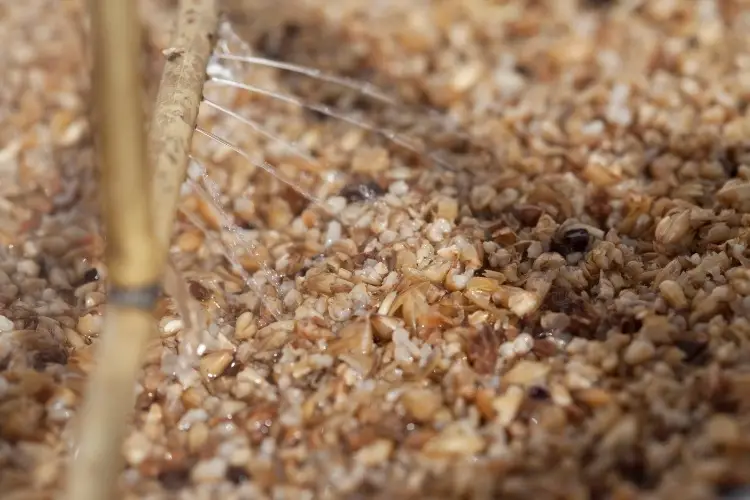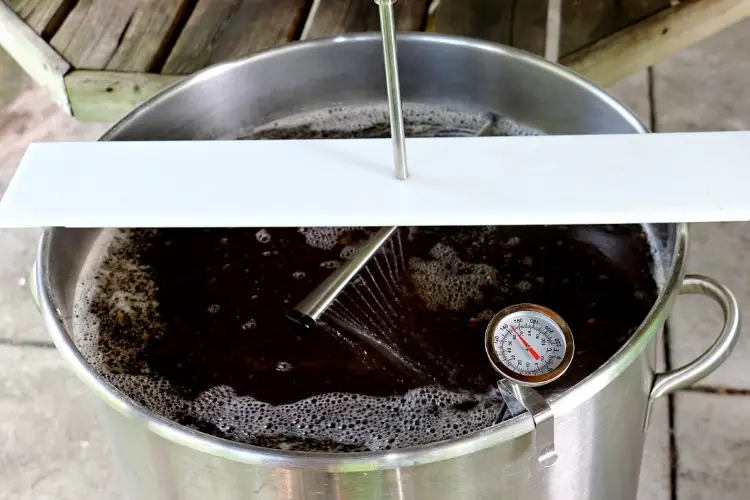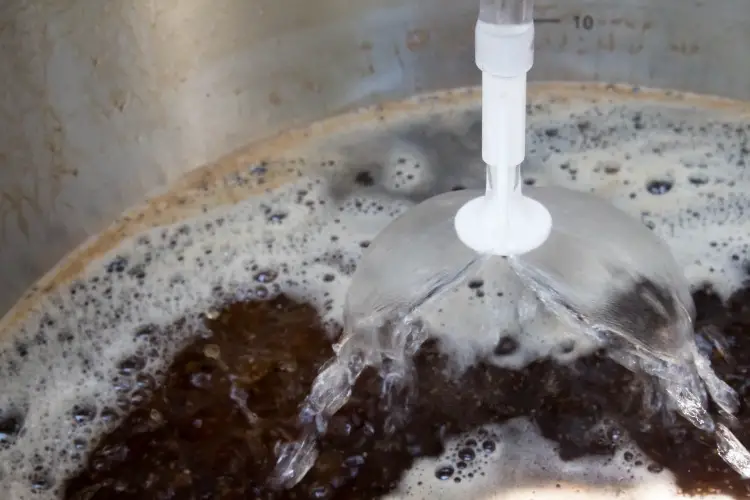Sparging is the process of spraying or pouring 170°F water onto mash to collect or rinse out any residual sugars left in the mash pile. While there are three different ways to sparge, they all follow similar steps and processes of pouring brewed water over your mash pile until the sugar is fully collected.
People who have been homebrewing for a while will argue that there is a “best” way to sparge. The issue with that statement is that it is incredibly subjective.
The “best” way to sparge is simply the way that allows you to achieve the flavor profile you are looking for in your homebrew.
Read on to learn about the sparging options you have.
3 Types of Sparging
Sparge is defined as “to moisten by sprinkling with water, especially in brewing,” so naturally, the process of sparging revolves around the same idea.
However, there are three different ways that you can sparge when you are homebrewing:
- Batch Sparge: Once you complete the first few runnings of your mash, and you are no longer getting liquid from the mashing process, you will pour all of the wort into your brew kettle. From there, you will add more hot water back into the mash pile and let it sit for approximately 20 minutes before you drain it and add more water. You will repeat this process until the pH of the wort is no longer more than 6.0.
- Fly Sparge: With this method, you will consistently add hot water to your mash the entire time it is draining. You will want to keep the water level just above the grain level to help ensure that when the sparge arm moves around, the water is spread more evenly.
- Dunk Sparge: Using this sparging process, once you collect your runnings, dunk the entire mash pile into another pot of water. Usually, 2 to 3 gallons is perfect. This will allow the water to separate the sugar from the mash without destroying the pH of the wort you already made.

Being knowledgeable of the mashing and the sparging process is incredibly important when you are learning how to homebrew.
These processes are what is going to make your beer taste the best and have the smoothest texture.
Each process is vastly different in the way they remove sugar from the mash; however, the result is always the same (when looking at product, not flavor).
Once you find a sparging method that you like best, or that gives you the richest flavor, do not try to stray from it.
Consistency is the key to a rich flavor that can be perfected.
No Sparge Method
While there are three ways to sparge, there is only one option if you do not want to include that part of the process.
Do not sparge your mash!
Not sparging will increase the amount of grain you use and double the amount of mash turnover.
Choosing to or not to sparge is an entirely personal decision based upon your desired flavor profiles.
No matter which route you go, you will spend time, money, and physical labor to achieve your results.
When Do You Stop Sparging?
Usually, you stop sparging once your runnings have a pH of 6.0 or higher.
Anything over a pH of 6.0 can be customized based upon your type of brew and the type of grain you are using.
Although, sparging too much can cause tannings to leach out into the brew and tannings can cause a very bitter taste as well as providing issues with the brew’s ability to chill correctly.
Another way to tell when you need to stop sparging is by doing a bit of math to figure out how much liquid you need to have in your pot pre-boil.
This means you have to account for the amount of water that will evaporate and estimate how much you need in the pot before you boil to achieve your desired amount.
This is not the easiest thing to figure out.
You can generally assume that water evaporates at a rate of anywhere from 1.5-2.5 gallons in an hour.
Once you figure out how long your brew needs to boil, follow these steps:
- Figure out how much water can evaporate during the boiling time.
- Then, add that amount of water when you sparge to compensate.
The sugars you remove from your mash will stay with your brew, but the extra water will evaporate instead of watering down the taste.
How do You Know if Your Beer Has Soured?
No one is perfect, and mistakes happen all the time.
If you believe that your beer has soured, there are quite a few signs you can look for.
If any of the following issues are happening, your beer has most likely soured:
- Your beer foams excessively when you open the bottle.
- It smells terrible.
- There is mold or a slimy layer on top.
- Your beer flavor is getting worse with time.
Making a mistake does not feel great, but it gives you a great chance to learn from it and never make the same mistake again.
Once you ruin an entire batch of beer, chances are you will not allow yourself ever to let that happen twice.
Your sanitation process and ingredients are the most important things that will contribute to the quality of your beer.
Here are some tips to help make sure you do not compromise the integrity of your homebrew:
- After every bath, clean every piece of equipment with household bleach and allow them to soak for at least 30 minutes. Any other scented or household cleaners can leave a film on your equipment.
- Use non-abrasive cloths and sponges when cleaning not to scratch your equipment. Scratches or dents are good places for bacteria or old yeast to hide and grow.
- Store your fermented beer in a cold and dark area so that nothing can grow.
- Always know the quality of your ingredients. If a price seems too good to be true, it probably is.
- Always trust where you get your ingredients from. Any inconsistencies in your ingredients can ruin your batch.
How Much Sparge Water Do I Need?
The amount of sparge you need for a homebrew depends entirely on how much beer you intend to make in the batch.
If you use the same amount of sparge for a three-gallon batch as you do for a 10 gallon, you are not going to get the correct results.
The amount of sparge necessary is also affected by the following variables:
- Grain bill (the amount of grain you are using in the mash)
- Mash thickness
- Grain temperature
For an easy way to calculate the amount of sparge you will need, you can check out several online calculators designed to estimate the amount of sparge you need based on the above variables and a few others.
For those variables that are unknown, average values are chosen to give you a general idea of the amount of sparge you will need.
To use a sparge calculator on your next batch for more precise measurements on your homebrew, check out this sparge calculator at More Beer.
What Temperature Should the Sparge Water Be?

The standard temperature for sparge water for homebrew is between 168-170° F (76° C).
Brewing with sparge at a higher temperature can lead to higher levels of tannins in the beer, causing it to have a bitter taste.
The problem with using this temperature range to direct a homebrewing operation is that homebrews often are exposed to cooler ambient temperatures because of the small containers the batch is being made in.
While the top of the wort may read at 168-170, the sparge may have cooled significantly by the time it actually reaches the grain bed.
It is most important that the temperature of the sparge water remains around 168-170 during the end of the mashing process since this is the point where the grains in the mash are most likely to give off bitter tannins if exposed to higher temperatures.
At the beginning of the boil, it is okay to exceed this temperature without causing damage to the flavor profile of the beer.
While hot water sparging is one way to sparge a brew, it is not the only way.
Many people sparge their homebrew batches with cold water, and some brewers do not perform a sparge process at all.
Can You Sparge with Cold Water?
Sparging can be done successfully with cold water; however, the resulting beer may end up significantly hazier than a beer that is sparged with hot water.
If physical appearance and clarity of the beer is not a significant factor, such as with hefeweizen and other cloudy wheat beers, then cold water sparge can work.
However, using cold water sparge versus hot water sparge does not save you time in the long run, since you will end up having to spend longer heating your lauter at the end of the sparging process if the wort is cool.
It does waste less energy, though, and it negates the need for a secondary pot to heat the sparging water.
The major advantage of heating sparge is that the water is already halfway up to a boil by the time you are ready to boil the wort, so that aspect of the process does not take as long to get rolling.
Since controlling the temperatures of your mash is a very important part of ensuring that your beer’s flavor profile remains stable, introducing methods to make this part of the process more efficient can help you end up with a better beer in the end.
There is also the matter of sugar solubility.
Many homebrewers believe that the sugars in a mash are more soluble at higher temperatures, meaning that heating the sparge increases the efficiency of converting sugars to fermented alcohol.
Can You Sparge with Wort?
In short, no. Sparging should not be done with wort.
The reason is that the wort is the same gravity, so essentially, it is like trying to wash dirty clothes twice, only using leftover dirty laundry water to wash them the second time and expecting them to get cleaner.
There’s already “dirt” in the wort, so you are not going to be able to rinse grains efficiently with wort.
If anything, you are likely to be losing efficiency in your brew rather than gaining it.
The major problem of sparging with wort is an issue of saturation—once a wort has already been saturated with sugars from the mash, it simply cannot take on more.
This is why fresh water is needed to help leech sugars out of the grain.
Rather than sparging with wort, a homebrewer can instead experiment with reiterated mashings, which are undertaken specifically to try and achieve a higher gravity in beer.
For a more in-depth explanation of how to accomplish reiterated mashes, check out this forum at Home Brew Talk.
Do You Need to Sparge with Brew in a Bag?
The whole point of “brew in a bag” (BIABs) setups is to help combine the processes of lautering and mashing in the same container to try and make homebrews more contained.
Technically, there is no need to sparge a BIAB setup to get a successful beer.
However, if you do sparge it, you are more likely to extract more fermentable sugars, which will result in a beer with a higher alcohol volume.
When you use a BIAB method to homebrew, the sparge water and mash water are typically combined in the same tun.
So, if you are trying to decide whether to sparge or not, you should do it before the step of adding your ingredients to the tun.
Often when sparging is done on a BIAB brew, the sparging is done by picking up the entire brew bag out of the mash pot, moving it to a secondary container, and steeping the BIAB bag in the secondary container of water at a 170 to 190 degrees Fahrenheit for ten to fifteen minutes.
Once the bag has been steeped, it should be squeezed to extract any of the remaining fermentable sugars, and the wort should be added to the main boil tun.
What Happens if You Skip the Sparge?
No sparge brewing can sound tempting to brewers who are short on either time or equipment, but there can be a loss of efficiency in the brewing process by skipping it.
Sparging is performed to extract as much sugar from the grains as possible without also extracting bitter tannins.
Beers that have not been sparged are likely to have a lower overall alcohol content as well as a lower specific gravity.
To perform a no-sparge brew, most brewers end up adding extra grain to make up the difference in efficiency—roughly 33% more grain.
The main downfall of no sparge brewing with added grain is that it often vastly increases the amount of tun space you’ll need to perform the brew, up to over thirteen gallons.
This is a larger batch than most homebrewers can efficiently handle on their own.
BIAB setups can also be done without sparging, and in the same way—extra grain is added to the bag to make up for the lack of sugar extraction in the sparge process.
Skipping the sparge does shorten your brew day, but it will also result in a lower gravity beer.
Conclusion
Sparging is the only way to remove as much sugar from your mash as possible.
This allows for a unique flavor profile because you get to decide just how little or how much gets added to your brew.
While there are a few ways to sparge, once you find one that works for you, stick with it because consistency is the key to perfection.
Once you find that perfect taste, you will not ever want to go back.

